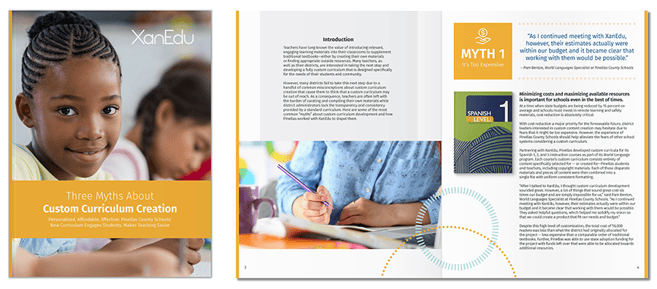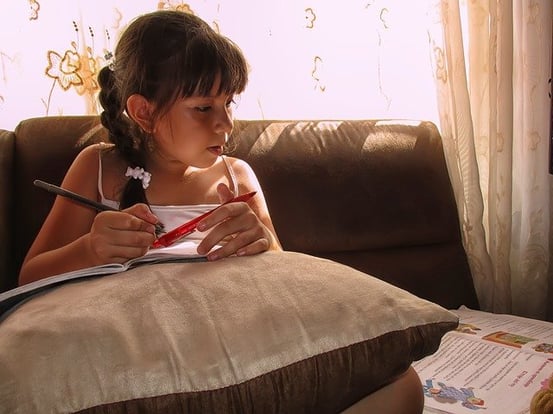Personalized, Affordable, Effective: New Curriculum Engages Students, Makes Teaching Easier

In the midst of transitioning to a new World Languages program, Pinellas County Schools (PCS) looked at their existing Greek and Spanish language materials and realized that they needed an upgrade to meet the needs of their students. With leadership from World Languages Specialist Pam Benton, resourceful PCS teachers had found multiple materials that they liked and were effectively using in the classroom, as well as a new teaching strategy they were looking to implement. PCS saw the opportunity to improve their Greek and Spanish language programs by creating customized instructional materials that not only align to those teaching strategies but also allowed for the inclusion of their existing and copyrighted materials. An experienced partner was needed, one that could manage the entire customized curriculum materials process – from permissions management to design and layout to publishing the resources for easy deployment across PCS. The district found that partner in XanEdu, resulting in a World Languages curriculum that is cost-effective, aligned to standards, and allows teachers to focus more on teaching and less on administrative tasks.
With 140 schools including neighborhood schools, magnets, career academies, technical and adult education centers, and the district’s own virtual school, Pinellas County Schools offers families a wealth of educational choices suited to individual student’s interests, talents and abilities. Located on Florida’s Gulf Coast, it is the eigth largest district in the state and the largest employer in Pinellas County. One of the district’s many strengths is the diversity of its nearly 102,000 pre-kindergarten through adult education students and the more than 80 choice programs that serve them.
“Our goal was to give our hard-working teachers materials that would make their jobs easier and allow them to focus more on teaching and less on administrative tasks.”
– Pam Benton, World Languages Specialist at Pinellas County Schools
Minimizing costs and maximizing available resources is important for schools even in the best of times. At a time when state budgets are being reduced by 15 percent on average and schools must invest in remote learning and safety materials, cost reduction is absolutely critical.
With cost reduction a major priority for the foreseeable future, district leaders interested in custom content creation may hesitate due to fears that it might be too expensive. However, the experience of Pinellas County Schools should help alleviate the fears of other school systems considering a custom curriculum.
Partnering with XanEdu, Pinellas developed custom curricula for its Spanish 1, 2, and 3 instruction courses as part of its World Language program. Each course’s custom curriculum consists entirely of content specifically selected for — or created for—Pinellas students and teachers, including copyright materials. Each of these disparate materials and pieces of content were then combined into a single file with uniform consistent formatting.
“After I talked to XanEdu, I thought custom curriculum development sounded great. However, a lot of things that sound great cost six times our budget and are simply impossible for us,” said Pam Benton, World Languages Specialist at Pinellas County Schools. “As I continued meeting with XanEdu, however, their estimates actually were within our budget and it became clear that working with them would be possible. They asked helpful questions, which helped me solidify my vision so that we could create a product that fit our needs and budget.”
Despite this high level of customization, the total cost of 56,000 readers was less than what the district had originally allocated for the project — less expensive than a comparable order of traditional textbooks. Further, Pinellas was able to use state adoption funding for the project with funds left over that were able to be allocated towards additional resources.

While custom learning content offers numerous benefits to students, teachers, and administrators, the creation process can seem highly complex. After all, most teachers and district administrators don’t have experience in copyright law or preparing materials for printing, which can make custom content creation seem impossibly difficult. However, XanEdu’s team of experts works hand-in-hand with districts and states across the country to help them navigate the creation process and simplify complex tasks like securing approval to use a copyrighted resource.
For example, the Pinellas County Schools and XanEdu teams worked together throughout the content creation process to develop the best possible resources for the district. XanEdu was able to secure the use of copyrighted materials as part of the readers.
“We were only able to include copyrighted materials in our workbooks because XanEdu could do the copyright work for us,” said Benton. “I didn’t have the experience to navigate the copyright approval process. That’s where the XanEdu team was so helpful.”
XanEdu also assisted with the design and formatting of the curriculum once the materials were selected to prepare them for print and practical classroom use. XanEdu’s editorial and design experts successfully sequenced Pinellas County Schools’ selected materials, created a table of contents, and applied a uniform design throughout the curriculum.
“Our goal was to give our hard-working teachers materials that would make their jobs easier and allow them to focus more on teaching and less on administrative tasks. Our student workbooks already include proficiency scales, reflection sheets, and copyrighted curriculum materials for each unit, ensuring that teachers don’t need to spend hours at the copier compiling materials for their students,” said Benton.
Further, Pinellas County Schools leaders were able to work with XanEdu and tap their team’s printing expertise to develop the optimal printing strategy in order to reduce costs as much as possible.

When many people are considering starting a custom curriculum process, they primarily think about how a custom learning resource might, for example, be able to include copyrighted materials or content that is more relevant to their local community. What types of learning content are included in a curriculum is obviously critically important. However, it is also important to consider how students and teachers will physically interact with the learning materials once they are printed and being used in the classroom. When developing their custom curricula, Pinellas decided to have the students’ readers printed with perforated pages. This seemingly small choice both reduced the cost of printing the materials and provided students with an easy way to pull out the relevant materials for each day’s lessons.
Learning materials can also be designed to provide teachers with a seamless user experience. When developing teacher manuals and professional development resources along with the new curricula, Pinellas worked with XanEdu to choose the printing format that best suited their teachers. As a result, Pinellas teachers’ materials will be formatted as binders so that they can easily add and remove content in the years to come.
“Our new workbooks and teacher resources look like materials that our teachers are familiar with, which is critical as this is a big change for them. For example, when opening up a manual, a teacher will see the table of contents and think that it looks like our curriculum guide,” said Benton. “XanEdu helped us give it a common look and feel, which is what brought it all together. It looks like a cohesive whole so teachers accept it as a cohesive whole.”
More broadly, print provides school leaders with another channel to engage with students, enabling interested districts and states to pursue a hybrid curriculum approach with both print and online elements. For example, District of Columbia Public Schools offers custom print curricula and houses the remainder of their custom curricula in their LMS. The State of Louisiana took a somewhat similar approach by housing instructional materials in their digital learning hub and offering print versions of those resources and their curricula’s copyrighted materials.
When selecting new materials for their classroom, leaders want resources that align to standards, support teaching strategies, and increase the amount of time teachers can spend engaging with their students. Fortunately, forward-thinking districts like Pinellas County Schools are providing important examples that custom curriculum development, when done with the right partner, makes teaching easier and ultimately, more effective.

Here’s a PDF version of this case study to print and share with others in your school district.
XanEdu’s K-12 CustomBook Solutions makes education personalized and affordable by giving districts and states control to create materials tailored to the unique needs of their students, rather than asking students to adapt to a standard, off-the-shelf resource. Working with more than 1,200 education institutions nationally, XanEdu helps learners at all levels of education access high-quality, student-centered, innovative learning resources.
Pam Benton, World Languages Specialist at Pinellas County Schools